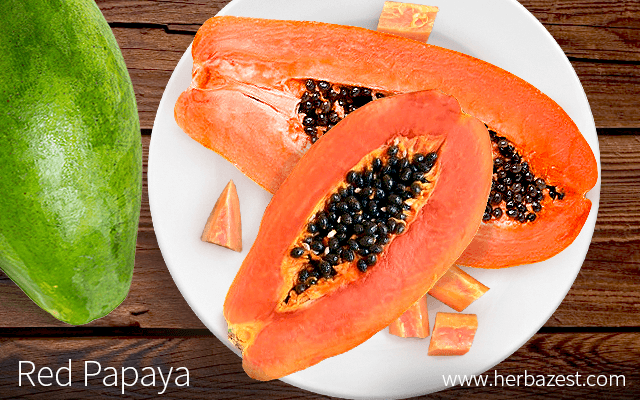The term “red papayas” usually refers to several of the deep red and salmon-colored papaya cultivars derived from the Hawaiian 'Solo' variety. A sweet and highly-fragrant fruit of about three pounds (1.4 kg) or less, the red papaya is used to treat a host of human illnesses, providing the same major health benefits as yellow papaya.
The Hawaiian papayas 'Sunrise Solo,' 'Sunset Solo,' and 'SunUp' are among the most popular commercially-available red varieties, but a few others, such as the Malaysian 'Eksotika' and the Colombian 'Zapote,' are also significant.
Red Papaya Benefits
Many red papayas have been carefully developed through specialized selective breeding programs, and they are favored for their growing quality, disease resistance, and superior flavor. For example, they exhibit only very rare incidences of fruit deformity during the winter months if grown with less climatic restriction.
Much like all other varieties, the red papaya benefits many of the body's internal systems with its antioxidant action. It is a heart-healthy herb that works to lower blood pressure, glucose, and low-density lipoprotein (LDL) cholesterol. It enhances immunization, protects the cells against free radical damage, and encourages speedy recovery from wounds and bodily trauma. Moreover, the red-fleshed papaya also boosts energy by helping the body break down usable nutrients from food.
Red Papaya Nutrition
The carotenoid lycopene is the predominant plant pigment found in red-fleshed papaya. It is a powerful antioxidant known for its protective and preventative medicinal actions. Even though yellow-fleshed cultivars also contain abundant amounts of carotenoids, this naturally-occurring phytoconstituent found in tomatoes, watermelons, and carrots has not been detected in this type of papayas.
The most significant difference between yellow and red papaya fruits is that red varieties contain more natural sugars and, therefore, a bit more calories per serving. Despite this, variations in red papaya nutrition are more or less negligible.
Both yellow and red papayas boast an extensive spread of phytonutrients, macronutients, vitamins, and minerals, including calcium, protein, carbohydrates, fats, and dietary fiber. Across all cultivars, ripe papaya fruits contain about 51.2 mg of vitamin C (ascorbic acid) per 100 gram serving, providing as much as 60 - 75% of the daily recommended intake. They also provide 2 - 10% of the recommended daily intake for vitamin A.
The Strawberry Papaya
The strawberry papaya is considered to be the sweetest red papaya of all, thanks to its high sugar content and fragrant notes of melons and berries. Developed in 1961 by researchers from the University of Hawaii, it is a cross of the two inbred 'Solo' strains 'Line 9' and 'Kariya Solo.'
After several generations of successful inbreeding, the strawberry papaya, or 'Sunrise Solo,' is now genetically stable. In its premium quality fruits, a firm texture, high sugar content, and good growth habits meet in harmonic symphony. With very little sterility, uniform and aesthetically-pleasing fruits set within nine months of planting.
While it has enjoyed immense commercial success, the strawberry papaya has a relatively short shelf-life and must be marketed and sold quickly.
Ever since their debut, red papaya varieties like the strawberry papaya have captured the hearts of tropical fruit lovers all over the world. Sweet, nutritious, and medicinally potent, the red papaya is an excellent addition to wholesome diets and well-balanced healthcare regimens.
Sources
- College of Tropical Agriculture & Human Resources, Papaya production in Hawaii, 2000
- Handbook of Energy Crops, Papaya, Carica papay L.
- International Tropical Fruits Network, Papaya – Common varieties
- Journal of Food Composition and Analysis, Ascorbic acid, vitamin A, and mineral composition of banana (Musa sp.) and papaya (Carica papaya) cultivars grown in Hawaii, 2006
- National Library of Medicine, Lycopene | Vitamin C
- U.S. Pacific Basin Agricultural Research Center, Vitamin and mineral content of tropical fruit cultivars grown in Hawaii
- University of Florida, An overview of US papaya production, trade, and consumption
- University of Hawaii, Sunrise solo: A different colored solo papaya | Carpellodyor cat face, papaya | Papaya production in Hawaii
- USDA Nutrient Database, Papayas, raw




